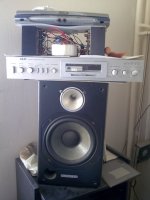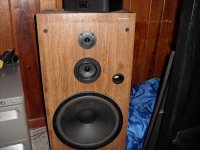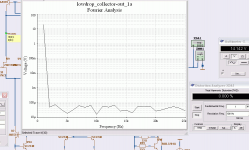Here a first little round of THD sims involving more or less popular
audio amps that are often displayed at DIY audio...
As first guests, the DX and Blame ES as well as 0stripper s AX2...
audio amps that are often displayed at DIY audio...
As first guests, the DX and Blame ES as well as 0stripper s AX2...
Attachments
Last edited:
Hi, Linup..
I retain Ostripper s design as base design for
future comparisons.
The Blame ES is not that bad, and is enough
for most speakers considering its 50W rating.
The DX should be definitively abandonned, as
it s lacking compared to the two others...
I retain Ostripper s design as base design for
future comparisons.
The Blame ES is not that bad, and is enough
for most speakers considering its 50W rating.
The DX should be definitively abandonned, as
it s lacking compared to the two others...
Next is an old design that is still well alive, i.e, Leach amp,
is compared to the winner of the first round..
Surprinsingly, despite its age, the old guy
is still relatively good.
The sims are made using modern devices, as
this allow valuable comparisons.
is compared to the winner of the first round..
Surprinsingly, despite its age, the old guy
is still relatively good.
The sims are made using modern devices, as
this allow valuable comparisons.
Attachments
I see you have started the thread. Total THD is not as important as it's content and how much of it occurs dependant on frequency.
In my tests , I check total THD at 200 , 1k , 10k , and 20k. The AX you mentioned has the lowest between 1k and 20k but rises when you test above 20k or below 1k. Other amps such as the symasym or apt (balanced single ended) have higher totals but are lower down to 100 or below and my GX will stay at .005% all the way to 40khz.
The DX by Carlos is a higher distortion unit , but sounds nice for a beginning DIY project. You add a CCS to it , you get lower distortion but lose sonics. It is what it is. 🙂
The fully complimentary amps like the leach almost fully cancel out the even order harmonic so you better have low or almost non-existent H3/5/7.
The reason to develop my own amp is to go modular so I can truly do side by side comparisons of all the major topologies in the real world.
Edit , one more point to make , simulate these voltage stages into a 2R load at higher power levels , simulating a "droopy" OPS , some will do much better than others.
OS
In my tests , I check total THD at 200 , 1k , 10k , and 20k. The AX you mentioned has the lowest between 1k and 20k but rises when you test above 20k or below 1k. Other amps such as the symasym or apt (balanced single ended) have higher totals but are lower down to 100 or below and my GX will stay at .005% all the way to 40khz.
The DX by Carlos is a higher distortion unit , but sounds nice for a beginning DIY project. You add a CCS to it , you get lower distortion but lose sonics. It is what it is. 🙂
The fully complimentary amps like the leach almost fully cancel out the even order harmonic so you better have low or almost non-existent H3/5/7.
The reason to develop my own amp is to go modular so I can truly do side by side comparisons of all the major topologies in the real world.
Edit , one more point to make , simulate these voltage stages into a 2R load at higher power levels , simulating a "droopy" OPS , some will do much better than others.
OS
Last edited:
.
Total THD is not as important as it's content and how much of it occurs dependant on frequency.
. The AX you mentioned has the lowest between 1k and 20k but rises when you test above 20k or below 1k. Other amps such as the symasym or apt (balanced single ended) have higher totals but are lower down to 100 or below and my GX will stay at .005% all the way to 40khz.
The DX by Carlos is a higher distortion unit , but sounds nice for a beginning DIY project. You add a CCS to it , you get lower distortion but lose sonics. It is what it is. 🙂
The fully complimentary amps like the leach almost fully cancel out the even order harmonic so you better have low or almost non-existent H3/5/7.
The reason to develop my own amp is to go modular so I can truly do side by side comparisons of all the major topologies in the real world.
OS
Hi, Ostripper
THD content is important, true, provided the THD is high
enough to be heard...
Although i prefer your recent design, that i also simulated, and
that will be displayed later, your AX still appeared as having
the best complexity/perfs ratio , so i elected to use it as timely
reference design for my sims..
The DX amp, well....i won t talk about it...
The fully symetrical amps have the advantage of
more balanced perfs, although they are more difficult
to master in matter of THD at low and medium frequencies
where the single differentials siblings are really hard to
beat considering their relative simplicity..
As to design your own amps, that s great , since you manage
to have fairly good results..
I m far from being as prolific as you , at least in the building
area..
w
Edit , one more point to make , simulate these voltage stages into a 2R load at higher power levels , simulating a "droopy" OPS , some will do much better than others.
OS
This wouldn t be a fair comparison, since some designs
use more than one power bjt pair, but at the same time,
using only one power devices pair for about 50W RMS/8R
is just not serious...
My second point in the last post is best illustrated below in the attachment.
The AX , while I will build it and it is proven .. a VERY good amp , will not do anywhere as well into a 2R load , standard single pair OP -EF2. It is will degrade substantially at the H7 and 9.
OS
The AX , while I will build it and it is proven .. a VERY good amp , will not do anywhere as well into a 2R load , standard single pair OP -EF2. It is will degrade substantially at the H7 and 9.
OS
Attachments
Last edited:
Not many amplifiers are built to do well at 2 Ohm.
So, no big thing AX is not for low ohm speakers.
For such we need to start parallel output devices, as you say.
I parallel sometimes just to lower distortion at hi-power out.
There are several benefits from parallelling.
So, no big thing AX is not for low ohm speakers.
For such we need to start parallel output devices, as you say.
I parallel sometimes just to lower distortion at hi-power out.
There are several benefits from parallelling.
Last edited:
My second point in the last post is best illustrated below in the attachment.
The AX , while I will build it and it is proven .. a VERY good amp , will not do anywhere as well into a 2R load , standard single pair OP -EF2. It is will degrade substantially at the H7 and 9.
OS
No doubt, but any amp will experiment a high increase in THD
with a 2R load...
You can increase the bias to reduce the switching distorsion
with those low value loads.
8R was the load value because almost all hifi speakers
are rated at this impedance.
Sure that there s some impedance dips, but they are
restricted to a narrow bandwith, and as, won t influence
significantly the real power output...
Not many amplifiers are built to do well at 2 Ohm.
So, no big thing AX is not for low ohm speakers.
For such we need to start parallel output devices, as you say.
I parallel sometimes just to lower distortion at hi-power out.
There are several benefits from parallelling.
For a truly fair test of a voltage stage , one would drive multiple pairs with a triple OP stage, assuring the least possible load on the Voltage amp. Considering the added stability issues and complexity of the triple ,most DIY'er 'shy" away from it and go the EF2 route. I am in that camp and want to give my EF2 the best voltage stage.
As far as a 2R load , some 4R bass drivers will demand this at certain frequencies. Not always , but occasionally.
OS
No doubt, but any amp will experiment a high increase in THD
with a 2R load...
You can increase the bias to reduce the switching distorsion
with those low value loads.
8R was the load value because almost all hifi speakers
are rated at this impedance.
Sure that there s some impedance dips, but they are
restricted to a narrow bandwith, and as, won t influence
significantly the real power output...
A lot of the hobbyist's (not audiophiles) that build on this forum will be "blasting" their cheap 4R Pyle drivers and other inefficient aftermarket loudspeakers. It is just reality. 😀 Some have peerless or vifa higher quality components but one must consider all end uses,even crazy ones like electrostatics or piezo tweeter (capacitive loads)
OS
Last edited:
Agree..
That said, at low frequency, the amps have tons of
available feedback.
Just check your AX thd at 200HZ...
About speakers, true that there s some exotic designs that
can display strange impedance curves..
Best is to have at least one pair of very good reference speakers
for sound comparisons purposes.
There s some good bargains with some professionnal users
that are renewing their studios monitors..
Mine were 1400$/pair at launch, i did buy them 250$ used, ten
years ago...
That said, at low frequency, the amps have tons of
available feedback.
Just check your AX thd at 200HZ...
About speakers, true that there s some exotic designs that
can display strange impedance curves..
Best is to have at least one pair of very good reference speakers
for sound comparisons purposes.
There s some good bargains with some professionnal users
that are renewing their studios monitors..
Mine were 1400$/pair at launch, i did buy them 250$ used, ten
years ago...
Attachments
strange HF drivers ??? whoa... I just use some big 150w sharps with 15" bass drivers. Actual 6R imp. and $25/pair at thrift shop , very expendable.
OS
They looks great..I love the wood finition..
At such a price, it s a no brainer..
The AKAI preamp you can see on top of
my speakers, i litterally saved it from a pair
of hand that were going to throw it in a scrapping
machine at the scrap yard..
No such things with speakers, even the old Celestion
or other 3A are still preciously kept used, often with PCs..
Following are two very popular designs from Rod Eliott,
a famed ingeener who has a very good site dedicated
to audio and some other nearby subjects...
Namely , the P3A and P101 are the simmed amps.
Elliott Sound Products - The Audio Pages (Main Index)
a famed ingeener who has a very good site dedicated
to audio and some other nearby subjects...
Namely , the P3A and P101 are the simmed amps.
Elliott Sound Products - The Audio Pages (Main Index)
Attachments
Next is an old design that is still well alive, i.e, Leach amp,
is compared to the winner of the first round..
Surprinsingly, despite its age, the old guy
is still relatively good.
The sims are made using modern devices, as
this allow valuable comparisons.
M. Leach amplifiers are really good.
By a guy that knows what he is doing (A Professor should know)
He has taken care of most things that can effect outcome.
----
About your sims.
What is the highest harmonics. Looks like 240kHz or more ....
In my MultiSim SPICE I can not do exactly those curves.
But I can do Fourier with any number of harmonics, usually 9
and use any fundamental frequency, usually 1 kHz
and present result in different ways.
I usually use bar graphs + decibel.
The closest to your way would to use Logaritmic scale without normalize graphs.
I really think you should NORMALIZE. Maybe there is some benefit not do?
Here is a test, which shows reesult for a +/-24 Volt Lowdrop Poweramp with JFET input.
Puts out 23.84 Vp into 8 Ohm .... 23.68 Vp into 4 Ohm
The output in diagram is at 20.0 Vp at 1 kHz and 8 Ohm.
Same as you have used.
This is quite high for a Powersupply +/-24 Volt
Attachments
About your sims.
What is the highest harmonics. Looks like 240kHz or more ....
In my MultiSim SPICE I can not do exactly those curves.
But I can do Fourier with any number of harmonics, usually 9
and use any fundamental frequency, usually 1 kHz
and present result in different ways.
I usually use bar graphs + decibel.
The closest to your way would to use Logaritmic scale without normalize graphs.
I really think you should NORMALIZE. Maybe there is some benefit not do?
Here is a test, which shows reesult for a +/-24 Volt Lowdrop Poweramp with JFET input.
Puts out 23.84 Vp into 8 Ohm .... 23.68 Vp into 4 Ohm
The output in diagram is at 20.0 Vp at 1 kHz and 8 Ohm.
Same as you have used.
This is quite high for a Powersupply +/-24 Volt
The maximum frequency is way higher than 240KHZ, i just
did make a zoom of the relevant part, as it s useless to
go to femto volts values.
Using a logarithmic scale allow to magnify the low order
harmonics which are proeminent unless the amp is unstable..
Extending the bandwith of fourier analysis require to
reduce the step of analysis, i.e, the resolution.
In your picture, it seems that it s 100HZ, that is 10mS.
I used 50nS (20MHZ) step for 10KHZ THD and 2uS (500KHZ)
for 1KHZ THD analysis..
Also, a significant number of sine cycles must be used to compute
accurately those numbers.
I used 20 cycles for 20KHZ and 10 for 1KHZ THD, as that seems
enough for my simulator, i.e Simetrix..
8ohm capable amplifiers must be capable of driving 4r0 without current limiting and should be able to drive 2r6 and still retain adequate voltage output.Not many amplifiers are built to do well at 2 Ohm.
....................
There are several benefits from paralleling.
4ohm capable amplifiers should be able to drive 1r3 under similar conditions.
Paralleling and adequate PSU are both necessary to achieve good 4ohm capability.
- Status
- Not open for further replies.
- Home
- Amplifiers
- Solid State
- Diy audio popular amps simulations



